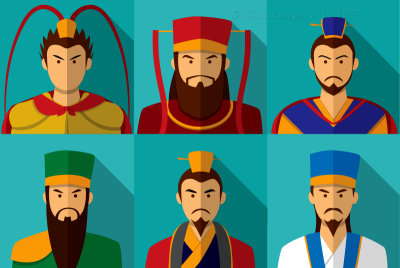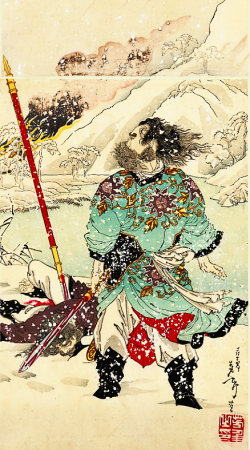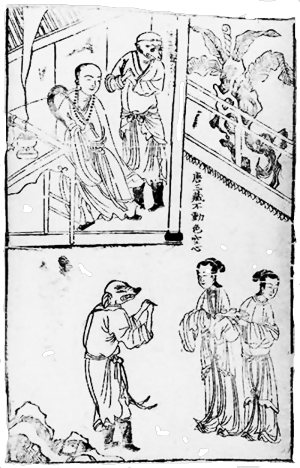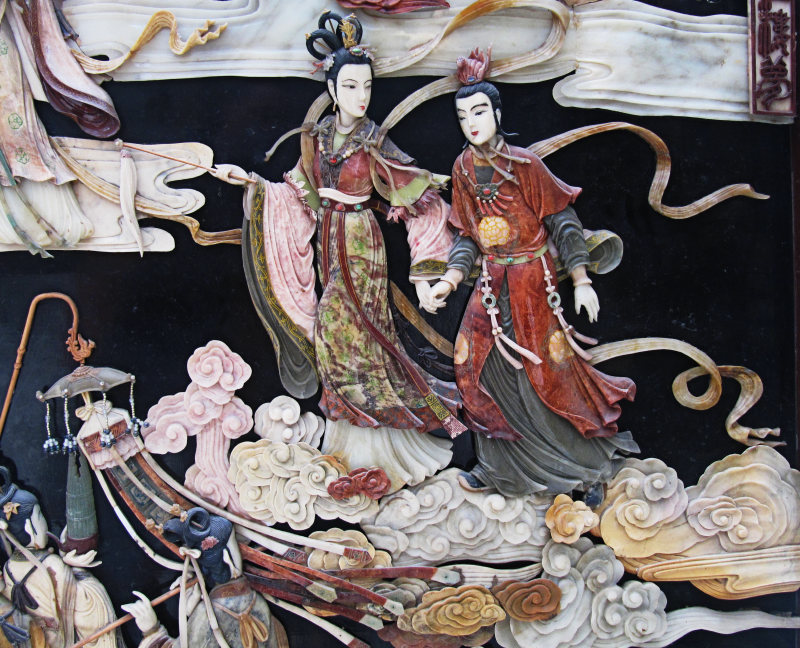Chinese Literature
Book publishing
Books have a long and distinguished history in China, after all it was in China that paper and printing were invented. The first European visitors in the early Qing dynasty were surprised by the number of books available compared to back home in Europe.
The first books were hand-written scrolls which each represented one chapter of text. In fact the Chinese character for a chapter 卷 juàn is a representation of a scroll of bamboo. In the early days of printing with carved wooden blocks the quality was rather poor. Often sections of 9th century Buddhist scripts are illegible but as these are often repeated mantras this did not matter too much. Shortly afterwards in around 953CE the Confucian classics were printed in Sichuan and also at the then capital Luoyang. These standard texts were printed under government license.
The next category of book to be printed were the dynastic histories and then Daoist scriptures in the late 11th century. The province of Fujian became the center for poor quality mass production of books between the Song to Qing dynasties (at Shufang) but there was also high quality printing in Sichuan, at Kaifeng and Hangzhou. Fujian was chosen because of the availability of cheap wood for paper making. It was in the Song dynasty that books rather than scrolls were printed. They were printed on one side of thin paper and the double page was stitched together at the binding. This made a 卷 juàn book. Large works were bound together with a stiff cover 套 tào.
During the period up to the 19th century it was found that printing from wooden blocks rather than moveable metal type was more cost effective. The carving of a wood block allowed the incorporation of rare characters and a range of script forms as well as illustrations. Blocks made of pear or jujube wood would last at least 1,000 impressions. This was much less costly than using copper but some prestigious projects did use metal blocks including the mammoth 古今图书集成 Gǔ jīn tú shū jí chéng of 800,000 pages. In the late 16th century color was introduced and these books soon became works of art in themselves.
In book publishing there are a number of different categories to consider:
The Classics
The books of ‘classical literature and science’ were written in a form that only scholars could understand. It diverged from the spoken language and required intensive study to master, characters were ‘visual cues’ rather than ‘spoken words’. So the classics for centuries remained the preserve of the scholarly élite. These classic books needed to be memorized word for word in order to pass the grueling government examination system. During the long dynastic history these study books were often collections and encyclopedias rather than works by single authors.
The Five Confucian Classics include the Yi Jing, Book of History (Documents) 书经 shū jīng covering history Early Zhou up to 626BCE) and Book of Odes 诗经 shī jīng - poems/songs from the early Zhou to 600BCE. The classics were inscribed on stone steles in 837CE at Xi'an and much later in 1793 at Beijing.
The classics soon started to attract learned commentaries to aid in their understanding. The first period of primary commentaries lasted until around 400CE and then up to about 1000CE secondary commentaries were written to explain the primary commentaries. There followed in the Song dynasty a reappraisal of all the classics and commentaries. As all these counted as ‘classics’ by the time of the Qing dynasty there were 1,776 classics in the Imperial library catalog 四库全书总目 Sì kù quán shū zǒng mù.
Sun Zi's Art of War 兵法 bīng fǎ
Although not a classic of Chinese literature this well known work comes from the same period of history as Confucius. It is a book of military strategy 孙子 sūn zǐ and tactics. Sun was an adviser to the state of Wu in war against the state of Chu. It is a short book of 13 chapters and has been influential and much studied worldwide. Mao Zedong studied it while fighting Chiang Kaishek's encirclement campaign at Jiangxishan.
Histories
China has the longest written continuous history. The Spring and Autumn Annals, often attributed to Confucius, covers events from the late Zhou dynasty and is one of the earliest history books. The great classical work is the 史记 Shi ji written by the Han dynasty historian Sima Qian. This was followed by Ban Gu's 汉书 hàn shū history of the Han dynasty. All future histories tend to slavishly follow Sima's style. From the Tang dynasty onwards a division of the government collected records to form the basis of the dynastic history. As these are official and written by Confucians there is quite a bit of bias in the reporting. Eventually 25 standard dynastic histories were compiled and have been recently republished with punctuation added (because classical text does not have this).
Novels
China lacks the ancient epic stories such as Beowulf ➚ found in other cultures. This may because of the work of Confucian scholars who selectively chose only those tales that back up their own doctrine. Poetry was considered the highest literary art-form. Novels were written in the vernacular 白话 bái huà rather than the scholarly 文言 wén yán script. Classical literature is written in a form that is unintelligible when recited as it uses so many homophones that can only be distinguished by reading the written form. It was only in the Song dynasty that the novel developed in China for ordinary people.
The mature modern novel appeared in the Ming dynasty, Confucian traditionalists still considered them frivolous and subversive and because of this little known is known about the authors. It was ordinary people that came to read them enthusiastically in the late Ming and Qing periods. There was also a tradition of oral story-telling going back millennium, it was only in the Ming that many of these tales were incorporated into novels. Novels were often retelling of distant historical events using well known characters. Even in Mao's era a leader could be criticized indirectly by alluding to a somewhat similar figure in history.
The move away from factual, dry histories and regimented poetry to a free form embracing everyday life was a very popular development. There are two broad categories: a fantasized re-working of historical events and realistic portrayal of family life - often with romance as the basis for the plot.
Popular literature
From about the 8th century onwards there was a ready market for cheaply printed short stories. A particularly popular genre are supernatural stories of which the Qing dynasty’s 蒲松龄 Pú Sōng líng’s ‘Strange Tales from a Chinese Studio’ 聊斋志异 Liáo zhāi zhì yì is the best known example.
There was a mass production of very cheap books from the Song dynasty onwards. Late Qing popular novels were often adventures where the virtuous always prevailed over the villains. They often lack literary merit and offered cheap escapism just as similar books do to this day all over the world.

Romance of the Three Kingdoms 三国志演义 Sān guó zhì yǎn yì
The authorship is generally attributed to Luo Guanzhong sometime before 1500CE and then it was 'finalized' by Mao Zonggang in 17th century. It tells a tale contrasting disunity and unity. It is a long book of 120 chapters covering a 100 year time period 168CE-265CE (the time of the Three Kingdoms). It turns this time of turmoil into a romantic age of chivalry reminiscent of the time of the Arthurian knights ➚. Cao Cao is unfairly portrayed as pure evil and Liu Bei as the perfect hero. In this way it lacks the subtlety of characterization of later novels. It is biased to the state of Shu's perspective and although written in vernacular Chinese is of a rather formal classical style.

About 70% of the featured events are rooted in history but romantic and dramatic incidents have also been added. One famous event covered is Liu Bei's strategic alliance to defeat Cao Cao at the Battle of Red Cliffs ➚ (now an epic film) with the help of Zhuge Liang. Another incident is the Peach Orchid oath where the good guys swore bonds of unswerving loyalty. It is also in this novel that Guan Di the ‘God of War’ has his origin. It is a much loved novel and it is the earliest and best example of a Chinese novel for the masses to read. It has been widely filmed including an epic 84 episode version on Central China TV.

The Water Margin 水浒传 Shuǐ hǔ zhuàn
This novel is loosely based on a minor rebellion at the end of the Northern Song 1120-21. It was written principally by Shi Nai'an but Luo Guanzhong may have written/edited the last 30 chapters. It was later revised and edited by Jin Shengtan around 1661. It tells the story of how 108 honest heroes were pushed into crime by a corrupt system. They lived as brave bandits in a Robin Hood-like world populated by acts of valor, justice, generosity, loyalty and contains tales of always perfidious women. The heroes hide out on Liang mountain, Shandong but in the end die heroically one by one. As with Robin Hood it is a little seditious - demonstrating the evils of the government administration which ordinary folk have to fight and the novel faced censorship at times. 宋江 Sòng jiāng is the main figure. It is written in pure vernacular with characters given individuality. It has received numerous adaptations. A famous English translation titled ‘All Men Are Brothers ➚’ was made by Pearl Buck.

Journey to the West 西游记 xī yóu jì or 'Monkey' 孙悟空 Sūn wù kōng
This much loved novel tells the tale of the travels of the monk Xuanzang ➚ who went to India to bring back Buddhist scriptures from India. The author Wu Cheng'en gathered and overlaid the descriptive narrative with folklore to make an entertaining masterpiece. There is a comic interplay between the monkey and pig characters. Monkey is a demon slayer with supernatural powers: a cudgel that could expand to any size and hairs that could become clones of himself. Monkey was made a companion to Xuanzang but monkey's pranks resulted in him being frequently dismissed from his service only for monkey to come back at nick of time to rescue him from danger. Monkey is admired for being loyal but mischievous, disruptive and defiant. A much loved 1980s TV series was made for children.

The Golden Lotus 金瓶梅 Jīn píng méi
This Late Ming novel was written by an unknown author. The Chinese title is the name of the three heroines Jin, Ping and Mei. It was one of the first to move away from legendary heroic quests. The plot is based on just chapters 33, 34 and 35 from the Water Margin but written in much greater detail. It describes how the Buddhist priest 武松 Wǔ sōng became a bandit - he discovers his wife has been unfaithful and takes his revenge. It describes domestic life in detail and is ground-breaking in having principal female characters. There are sex scenes (but not over emphasized) and so met with the disapproval of the Christian missionaries. Although a clear move towards a realistic novel it is not generally considered one of the top four novels.
The Scholars 儒林外史 Rú lín wài shǐ
This novel was written by Wu Jingzi in the 1730 or 40s . It tells the tale of minor nobility who turned against the official system and took to a life of charitable giving. It is a bitter denunciation of the hypocrisy of the administration by scholar officials. It is not generally considered one of the top novels but boldly took the step of criticizing the Confucian order.

Dream of the Red Chamber 红楼梦 Hóng lóu mèng
Cao Xueqin is credited with writing this book in the mid 18th century, although the last third of the book was written by another author Gao E 高鹗. It is an intimate story of a family that had fallen from opulence since the Ming dynasty into squalor. It is largely autobiographical and even though written in the vernacular manages a fine literary style. It tells of a young man's (贾宝玉 Jiǎ Bǎoyù precious jade) doomed first love for his cousin. Baoyu is idle, 'artistic' and indifferent and so not a conventional hero. The novel is steeped in the realism of imperfect relationships and pragmatic choices. It makes subtle criticisms of the prevailing tight rules of behavior. It is also a call for revolt against the traditional arranged marriage, raising hopes marriages could be for love not duty.
Modern Literature
It was in the early 20th century that literature changed dramatically. Leading writers such as Lu Xun wrote in the vernacular and addressed the concerns of ordinary people rather than scholars and the leading families. These writers had access to western literature and were heavily influenced by it. A great many modern short stories and novels were written aimed at working people in ordinary not literary language. Since the founding of the Republic of China all forms of novel have appeared and are widely read.
In the Cultural Revolution all art was turned to promoting the Communist message. The movement included literature and only the works that followed the revolutionary spirit were permitted. Yang Mo's Song of Youth ➚ is an example of this genre. The plot-lines are all the same: a poor, working person is degraded and exploited by foreigners and capitalists; then by joining the Communist party and taking part in heroic revolution, life blossoms into victory and happiness. Chairman Mao stated that art and literature are 'an indispensable part of the entire revolutionary cause'.
Since the 1980s the controls on permissible literature have relaxed a little, but some politically sensitive topics are still banned ➚. For example “Serve the People ➚” by Yan Lianke.